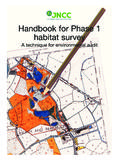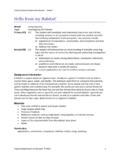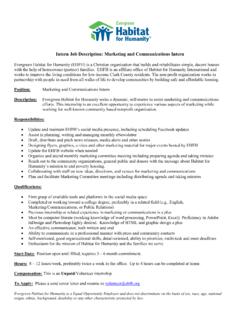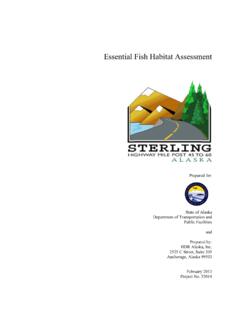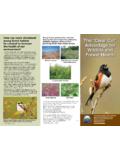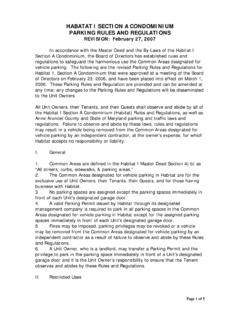Transcription of Handbook for the Habitat Simulation Model - …
1 Schneider & Jorde Ecological Engineering GmbH University of Stuttgart Institute of Hydraulic Engineering Handbook for the Habitat Simulation Model Module: CASiMiR-Fish Base Version SubstratKolke und GumpenUnterst ndeWassertiefeLicht und SchattenStr Suitability Index HSI [-]Zugeh rigkeitsfunktion [-]lowmediumhighvery high01000200030004000500060000 5 10 15 20 25 30 35 40 45 50 55 60 65Q [m /s]WUA [m ]Aesche, adultAesche, laichendHabitateignung HSI [-]:SubstratKolke und GumpenUnterst ndeWassertiefeLicht und SchattenStr mungSubstratKolke und GumpenUnterst ndeWassertiefeLicht und SchattenStr Suitability Index HSI [-]Zugeh rigkeitsfunktion [-]lowmediumhighvery high01000200030004000500060000 5 10 15 20 25 30 35 40 45 50 55 60 65Q [m /s]WUA [m ]Aesche, adultAesche, laichend01000200030004000500060000 5 10 15 20 25 30 35 40 45 50 55 60 65Q [m /s]WUA [m ]Aesche, adultAesche, laichendHabitateignung HSI [-]:Habitateignung HSI [-]: Last Revision.
2 October 2010 Written by Matthias Schneider, Markus Noack, Tobias Gebler and Ianina Kopecki Translated by Jeffrey Tuhtan CASiMiR-Fish Module Handbook Schneider & Jorde Ecological Engineering GmbH Institut f r Wasserbau, Universit t Stuttgart Copyright and License Agreement All rights reserved. This document and the accompanying software contain copyrighted in-formation. The unauthorized reproduction, translation, compilation, and/or distribution of the documentation and software are not allowed without the prior written consent of the owners. This text may contain reference to proprietary software offered and owned in whole by third-party entities such as "Microsoft Windows" und "MS-DOS".
3 The authors of this document assume no responsibility or liability with regard to references of proprietary third-party soft-ware which may be found in this text. Note The company sje Schneider & Jorde Ecological Engineering GmbH and the Universit t Stuttgart assume no liability or responsibility for the contents of this documentation and/or the accompanying software. Any claim for damages must be brought forth with accompany-ing proof of premeditation or an act of gross negligence. The software is subject to change due to further technical development, and thus this docu-mentation may contain errors and/or omissions which may therefore not reflect the exact condition of the software and/or documentation.
4 Contact Information: sje - Schneider & Jorde Ecological Engineering GmbH Viereichenweg 12 D-70569 Stuttgart Phone: +49-(0)711-677-3435 Fax: +49-(0)711-677-3436 E-Mail: URL: Universit t Stuttgart Institut f r Wasserbau Lehrstuhl f r Wasserbau und Wasserwirtschaft Pfaffenwaldring 61 D-70569 Stuttgart Phone:+49-(0)711-685-64752 Fax: +49-(0)711-685-64746 E-Mail: URL: 2 CASiMiR-Fish Module Handbook Schneider & Jorde Ecological Engineering GmbH Institut f r Wasserbau, Universit t Stuttgart TABLE OF CONTENTS 1 INTRODUCTION 5 Habitat Modeling 5 Current Developments of the CASiMiR Modules 5 Modeling Principles 6 Preference Functions 6 Fuzzy-Logic 7 2 THE CASIMIR-FISH MODULE 8 Typical Applications 8 Running a Simulation Using CASiMiR-Fish 9 Model Results 10 3 INSTALLATION UND START 11 System Requirements
5 11 Installing CASiMiR-Fish 11 Starting the Program 11 Closing the Program 12 Uninstalling the Program 12 4 PROGRAM APPLICATION 13 Project Description 13 The First Steps with CASiMiR-Fish 13 Opening Geometry and Water Surface Elevation Data 13 Visualizing Hydraulic and Structural Parameters 15 Evaluation of Reach Characteristics 19 Importing Habitat Preference Data
6 20 Visualizing the Habitat Suitability 20 Evaluation of Habitat Suitability 22 Creating Fish Plans 24 3 CASiMiR-Fish Module Handbook Schneider & Jorde Ecological Engineering GmbH Institut f r Wasserbau, Universit t Stuttgart Model Calibration 26 Conveyance (flow efficiency)
7 Factor 26 Modifying Preference Functions and Fuzzy Sets 28 Modifying the Structural Parameters 31 Additional Options 33 Importing Discharge Hydrographs 33 FST-Hemisphere Calculations 34 Visualization Options 36 Copying and Saving Graphics in CASiMiR-Fish 36 Inspection of Datasets in CASiMiR-Fish 37 5 CREATING YOUR OWN PROJECT 37 Project Requirements 37 Input Data and File Formats
8 38 River Geometry and Structure Data 38 Water Surface Elevation Data 44 Habitat Requirements Data 45 Flow Velocity 49 6 ASSESSING Habitat CONDITIONS 50 7 REFERENCES 52 4 CASiMiR-Fish Module Handbook Schneider & Jorde Ecological Engineering GmbH Institut f r Wasserbau, Universit t Stuttgart 1 Introduction Habitat Modeling Ecological systems such as rivers and their habitats are complex systems showing a wide variety of relationships between biotic and abiotic components.
9 Habitat models can be an appropriate instrument for studying the ecological functions of these systems, allowing for the qualitative assessment of Habitat conditions for the indicator species. Thereby the main advantages of Habitat models are justified in the following: The ecological state of an aquatic ecosystem is directly coupled with the living conditions of the typical resident species. Habitat models allow for the effects of changing flow rates and structural charac-teristics to be accounted for, and to some extent, can be used to predict their im-pacts. Flow rate changes influence primarily water depth, flow velocity, and substrate conditions, all of which are the major factors when determining the Habitat suitabil-ity and can be directly evaluated with numerical models.
10 Due to the direct relationship between Habitat conditions and flow rate, a quantita-tive basis can be established whereby an overall ecological-economical assess-ment can be performed. The European Water Framework Directive 2000 (WFD) lists fish as a key indicator species for the determination of a river s ecological status. This is due to the high level of temporal and spatial variability of fish Habitat requirements, as well as their place at the top of the food chain. Current Developments of the CASiMiR Modules In the early 90s, the Institute of Hydraulic Engineering of Stuttgart University developed CASiMiR (Computer Aided Simulation Sy)
